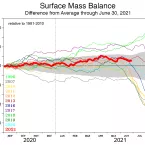Our Research
Related News & Stories

Scientists at Northern Arizona University, Arizona State University, the Arizona Geological Survey at the University of Arizona, and the National Snow and Ice Data Center at the University of Colorado Boulder have been awarded almost $2 million fr
As of July 13, Arctic sea ice extent was tracking just below the 2012 record and very close to 2020, the years with the lowest and second lowest (tied with 2007) minimum ice extent in the satellite record.
At the end of the first week of July, Arctic sea ice extent was tracking at record low for this time of year. July is the month with most rapid sea ice decline.


A stormy May over the eastern Arctic helped to spread the sea ice pack out and keep temperatures relatively mild for this time of year. As a result, the decline in ice extent was slow.